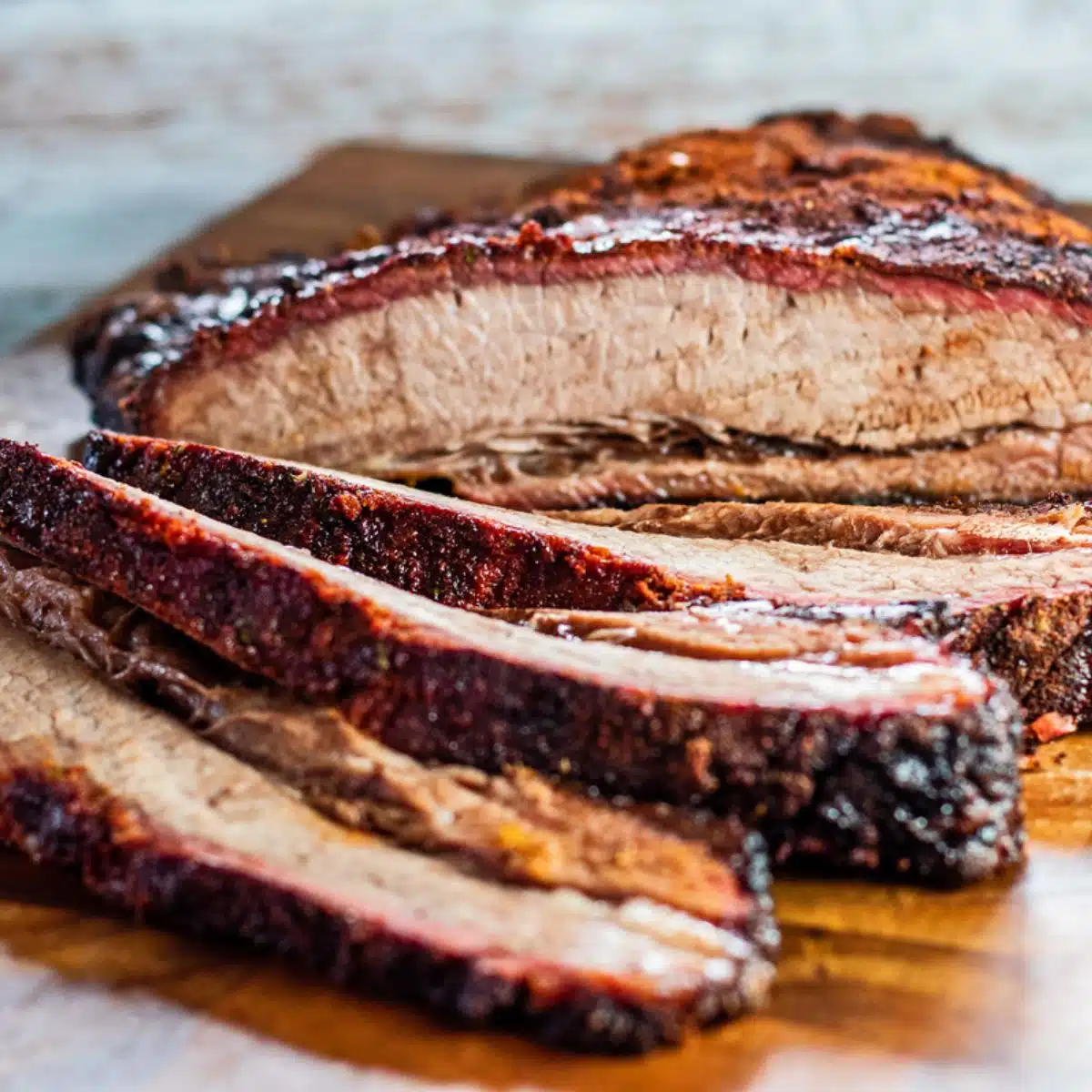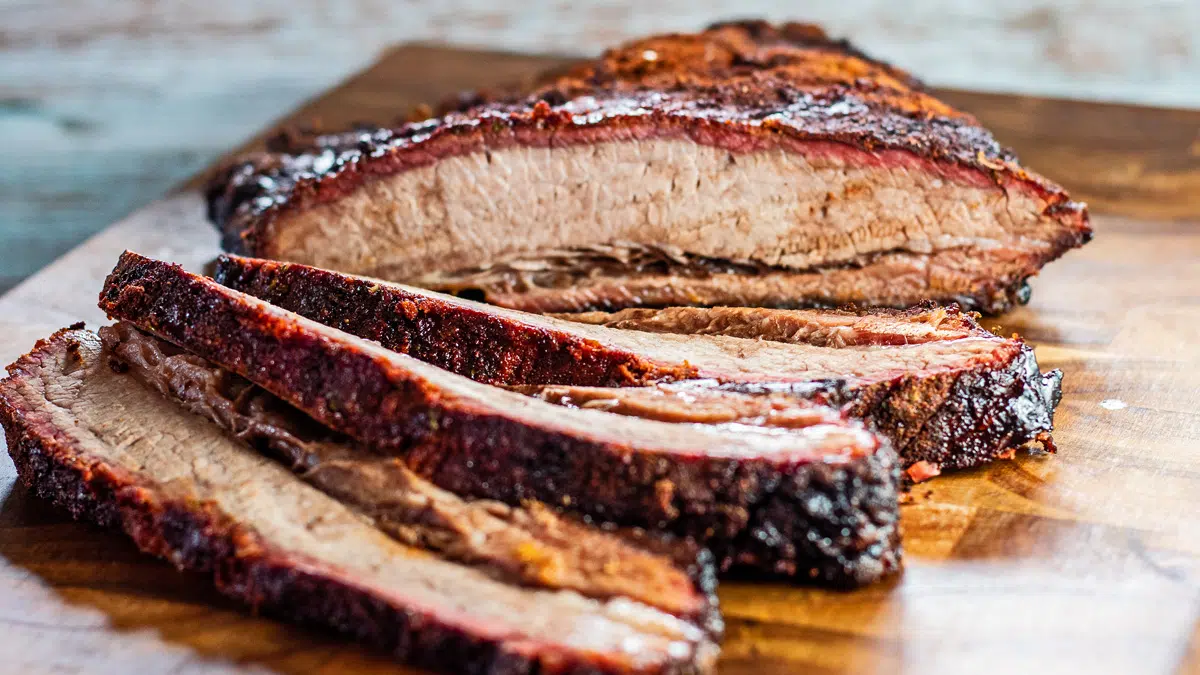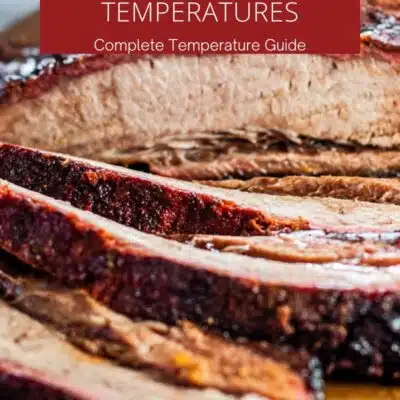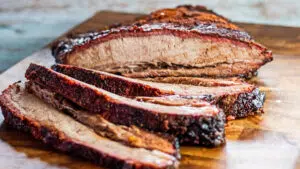Brisket internal temperatures are the most surefire way to guarantee your brisket turns out wonderfully juicy and tender. Undercooked brisket is almost as bad as overcooked brisket, so grab a meat thermometer to get rid of any doubt. Once you learn how to check the internal temperature of your brisket the right way, you'll get fabulous results every time.

Jump to:
Internal Temperatures For Brisket
If you're looking to make the best brisket, you'll need to know the ideal brisket internal temperatures. This is because cooking times and temperatures are the most important factors in tender, juicy brisket.
If the internal temperature is too low, the brisket will be tough. On the other hand, if the internal temperature is too high, the brisket will be overdone and dry. With these tips and tricks, you won't have to worry about either, and you can enjoy perfectly cooked brisket every time.
If you're looking to test out these tips and tricks, my Traeger smoked brisket or oven-baked brisket recipes would be a great place to start!
Ideal Brisket Internal Temperatures
In general, it's agreed that brisket should be cooked to no less than 190°F (88°C) and no more than 210°F (99°C). I find the sweet spot is right at 204°F (95°C) for the most succulent brisket.
Staying between 200°F (93°C) and 204°F (95°C) is ideal for a brisket point, and anything over 210°F (99°C) tends to be dry. If you are planning to shred your brisket rather than slice it, aiming closer to 208°F (42°C) makes it easier to shred.
The flat part of a brisket is leaner than the point and will dry out more easily. If you are cooking a brisket flat, it is best to stick closer to 195-200°F (90-93°C) whether you are going to slice or shred it.
These temperatures are the ideal final temperature for the rested brisket, so be sure to keep carryover cooking in mind when you are getting ready to pull your brisket.
Carryover Cooking
When meat is removed from a heat source and set out to rest, it continues to cook from the residual heat. Your brisket will cook about 5°F more after you pull it from the grill, oven, or smoker.
This is important if you are trying to reach a very specific internal temperature. You'll want to remove your brisket from heat and set it aside to rest once it reaches 5°F shy of the temperature you are aiming for.
>>>See All Of My Tasty Recipes Here!<<<

How To Measure The Internal Temperature Of Brisket
A meat thermometer is the best tool to check the accurate internal temperature of a brisket. While this technique should be employed when cooking any type of meat, it's especially important for preparing a delicious brisket!
A meat thermometer ensures that the meat has been cooked to perfection and is safe for consumption. Keep in mind the USDA recommends beef have an internal temperature of 145°F (63°C), but brisket is tough at this temperature, and you would be in for a disappointment.
That's why a thermometer, or temperature probe, is so important! You are aiming for a very specific internal temperature with brisket, where the meat is juicy and tender but not dry. A meat thermometer is the only way to be certain.
Once you are within the desired temperature range, you can judge how tender your brisket is by how easily the thermometer probe slides into the meat. If it feels like cutting through warm butter, your brisket is ready to be pulled.
How To Get The Most Accurate Temperature
Cooking beef to the right temperature requires more than just a thermometer - it's also vital to understand how to use it properly. You should always insert the thermometer into the thickest part of the meat, as this is the last to cook and will give you the most accurate temperature reading.
Remain still for 30 seconds before slowly pulling back about ¼ inch for a second reading. This helps confirm whether or not your beef is cooked evenly throughout.
How To Rest Brisket
Once your brisket is removed from heat, it's time to rest it. This step should never be skipped, as it is an important part of the process when making a perfectly tender brisket!
Transfer your brisket to a cutting board or serving tray and cover it loosely with a piece of foil. Let it rest for 15-30 minutes before you slice it against the grain.
To make your brisket into a full meal, you have to pair it with the right side dishes. Check out my post on what to serve with brisket for suggestions!
Brisket Internal Temperatures Reference Chart
| Brisket Cooking Temperature | Cooking Time | Ideal Internal Temperature |
|---|---|---|
| 225°F (105°C) | 1 hour 30 minutes per pound | 200-204°F (93-95°C) |
| 250°F (120°C) | 1 hour 15 minutes per pound | 200-204°F (93-95°C) |
| 275°F (135°C) | 1 hour per pound | 200-204°F (93-95°C) |
| 300°F (150°C) | 30-45 minutes per pound | 200-204°F (93-95°C) |
I hope this guide to brisket internal temperatures answered any of the questions you may have had on your mind! If not, feel free to reach out in the comments below, and I will get back to you!
😋 More Tasty Beef Roasts
- Beef Top Round Roast - This roast with a caramelized crust and juicy, succulent meat is the ultimate comfort food.
- Instant Pot Rump Roast - Toss some veggies in your Instant Pot with the rump roast, and you'll have dinner ready in no time!
- Roast Picanha - Treat yourself to a succulent Brazilian roast dinner with this easy recipe!
- Standing Rib Roast - This bone-in prime rib roast makes the perfect centerpiece for special occasions.
- Yankee Pot Roast - A melt-in-your-mouth tender pot roast complete with carrots, onions, and potatoes!
- Instant Pot Chuck Roast - With this recipe, you can have a hearty beef dinner ready in only an hour!
Do you love a recipe you tried? Please leave a 5-star 🌟rating in the recipe card below and/or a review in the comments section further down the page.
Stay in touch with me through social media @ Pinterest, Facebook, Instagram, or Twitter! Subscribe to the newsletter today (no spam, I promise)! Don't forget to tag me when you try one of my recipes!
📖 Recipe Card
Brisket Internal Temperateures: Traeger Smoked Brisket (+Tips For Making The Perfect Brisket!)
Ingredients
- 10 lb beef brisket
- ½ cup apple cider vinegar
- ½ cup water
- ½ cup mustard
- 2 cups brisket dry rub (1 whole batch of our brisket dry rub)
(Note: 2x or 3x only changes the ingredient list)
Instructions
Trimming Your Brisket
- To prepare your brisket, flip it upside down (so the fat cap is on the cutting board) and use a sharp knife to trim any excess fat or silverskin from the underside. Then, locate the large, moon-shaped area of pure fat and slice it off in a sawing motion. It does not need to be 100% removed, just enough to level it off with the rest of the brisket so it will cook evenly.
- Square your brisket by trimming the long, thin strips of fat off the sides. No need to fully remove it all, just trim until the meat is as uniform in shape and thickness as you can make it. Do the same to the ends of the brisket. Keep in mind, the point of the brisket will be somewhat knobby and not uniform and that is fine. Simply remove any loose or hanging meat to prevent it from burning.
- Flip your brisket over and trim the fat cap. You want it to be between ¼" and ½" in thickness all the way across. Once your brisket is looking fairly uniform all the way around, you're ready to get smoking.
Smoked Traeger Brisket
- Preheat your smoker to 300°F (150°C) and make a 50/50 solution of apple cider vinegar and water in a food-grade spritz bottle. Set aside. Slather mustard on all sides of your prepared brisket, then season generously with the brisket dry rub.
- Once your smoker has come to temperature, place the seasoned brisket fat-side-down on the grill grate. Cook for 1 ½ hours undisturbed.
- After 1 ½ hours, spritz the brisket with the apple cider solution. Do this every 30 minutes for another 1 ½ hours or until the brisket reaches an internal temperature of 204°F (95°C).
- Remove your brisket from the smoker and place it on a serving tray or large cutting board. Tent a piece of foil loosely over the top and let it rest for at least 15 minutes.
- Slice your brisket against the grain and serve!
Notes
- Though I did not brine my brisket, many people opt to brine it overnight in a sugar and salt solution and that is fine if you prefer.
- Resting your brisket is essential in keeping it tender and juicy! This gives the meat enough time to re-absorb its own juices as it sits.



KF says
This was really helpful, thank you! I usually sous vide my brisket but my sous vide wouldn’t turn on and I had a dry-brined brisket I had to cook. Used your notes here and it turned out great!!
Angela Latimer says
Oh I am so glad that it was helpful! It makes me so happy when I get to feel like I saved the day (or dinner at least). Thanks for sharing!